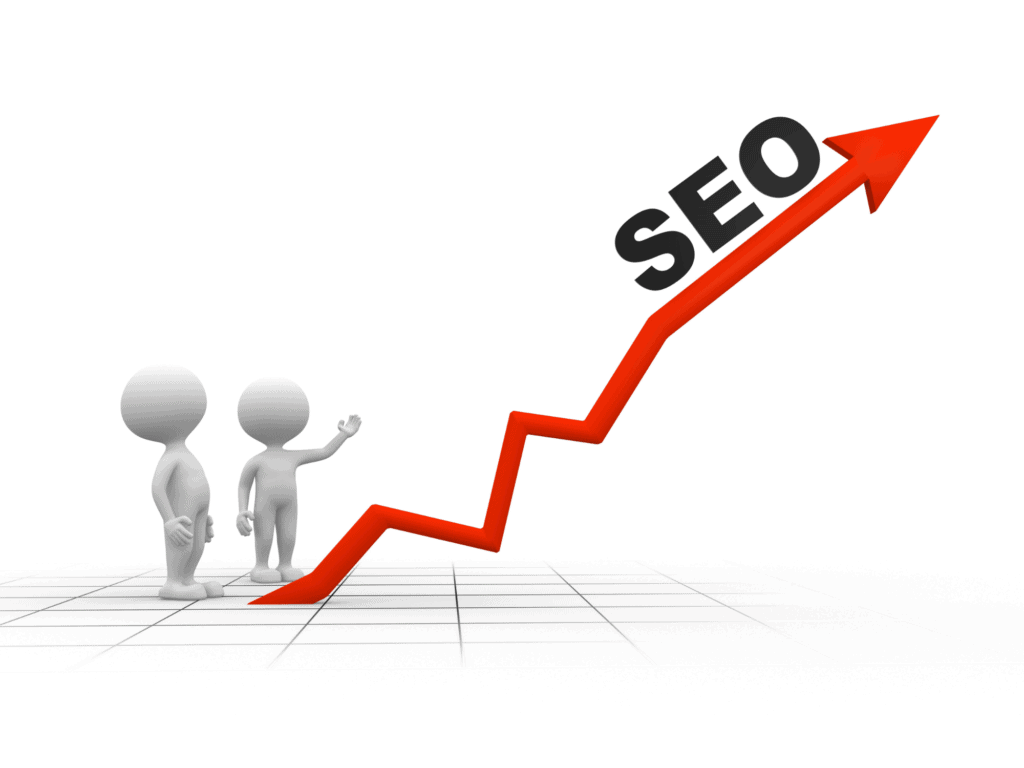When you learn about a new topic, company, or product, what’s the first thing you do? If you’re like most people, you put the name into a search engine like Google and hit enter. Those first entries on the web are your initial introductions to the topic. What company wouldn’t want access to that real estate.
SEO is how companies earn that top website rank on the first page of a search engine. Better rank means more people see your content, product, service, etc. as they search for the answer to the question or the solution to their problem. When you optimize your content, you give yourself the power to get in front of the customers first. You answer their questions and address their needs ahead of your competitors.
Here’s your business’ guide to SEO…
Table of Contents
- What is SEO?
- The Science Behind SEO and Why it Works
- When Does SEO Work?
- SEO Makes the Difference
- Implementing SEO
What is SEO?
SEO, or search engine optimization, is a set of practices designed to improve the appearance and positioning of your website in organization search results on a search engine. For this guide, we’ll use Google in all our examples.
Organic search is the most common way that people discover and access online content. Organic search results are the unpaid results that appear on a search engine after you make a query. So, for example, if you type “shoes” into Google, the results you see are often generated based on SEO factors. These factors are backlinks, domain authority, relevance, keywords, etc.
You may also see paid search results in the form of pay-per-click (PPC) ads. These are easy to identify because they have the term “Ad” by the URL. PPC ads provide you with the coveted top spots, but you have to pay for them. If you stop, your visibility disappears.
On the other hand, organic search is a strategy that businesses can work on over time. Marketers consider this a long-term source of traffic because SEO requires constant maintenance. It’s not a one-time process. So, while you’ll be updating your website or constantly adding new blogs, you’ll see consistent lead generation and revenue from those efforts because it’s a non-disruptive form of content delivery.

The Science Behind SEO and Why it Works
There’s science behind SEO — search engines today rely on machine learning and artificial intelligence — but there’s never been and will never be an exact science. Marketing and SEO experts will tell you that. As a result, when they’re creating a long-term strategy, companies often question whether SEO works and if this is the best use of their time.
The answer is yes, but why is that? How does it pay off for a business in the long term? SEO has a set of best practices. Some of these practices include:
- Aligning your content with search intent
- Adding your main keyword early on in your content
- Writing compelling title tags and meta descriptions
- Optimizing your images
- Boosting your website speed
- Building and internal linking structure
- Improving user experience
- Making URLs SEO-friendly
- Earning authoritative backlinks
- Creating useful content
However, these practices are only “best” practices because Google’s algorithm says so. The best practices for SEO change based on the ever-evolving algorithms dictated by search engines. Hypothetically, Google could decide to boost all websites with blue backgrounds tomorrow. If that were the case, nearly all websites would have blue backgrounds as a result.
The current SEO best practices are far less random blue backgrounds, but you should always remember that SEO is built around Google’s preferences. As these change over the years, your SEO practices should shift to match those parameters.
Sometimes, SEO gets the reputation of being ineffective. This is because people are employing outdated practices that cause their content not to rank well. As a result, you must stay up to date on Google’s current guidelines. You don’t want to be playing by an obsolete rulebook.

Content Optimization
Content creators, marketers, editors, and subject matter experts are responsible for the content optimization of a website. They create the website content, blogs, videos, etc. that compel people to engage, share, and link to your company’s content. Their goal is to inform, educate, inspire, and possibly even sell your company’s product or service. Any content you put on your website should be relevant, useful, and reliable.
When optimizing content for SEO, you must integrate several elements such as keyword research, search intent, and domain authority. These tactics allow you to rank on search engines when combined with technical optimization.
Here are some factors that content creators should remember when optimizing for SEO:
1. Relevance and Keyword Research
As a content creator, you want to create relevant content. Relevant content walks the line between familiarity and curiosity. It connects to what they’re already thinking about while slightly pushing their limits and causing them to want more information because they’re excited and interested.

When you do keyword research for a topic, you identify the words or phrases your audience will type into a search engine to find results for their query. This process allows you to use search relevance to amplify content relevance. Keyword research should be performed before you start writing so that all content you create aligns with what your audience is already interested in.
2. Usefulness and Search Intent
You create useful content when it translates into a value or action for your reader. The most useful content is that which answers a question or solves a problem — and is easily accessible when someone makes a query in a search engine. If someone typed, “Where can I buy tickets to the Red Sox game?” you want ticket sellers for the Boston Red Sox to pop up. This solves the problem of the searcher.
There are four types of search intent on the web…
- Informational: seeking an answer to who, what, when, why, how
- Commercial: researching or evaluating a purchase
- Transactional: ready to purchase
- Navigational: trying to get to a specific page without typing in a URL
When you align your content with one of the four types of search intent, you can make it useful to those who find it. The example above was transactional search intent. They were ready to purchase tickets and needed to find a vendor.
3. Credibility and Domain Authority
Credibility on the web helps readers trust your content and have confidence in the value you promise. Some companies and brands can draw on inherent credibility while others need to borrow credibility from statistics or testimonials.
Domain authority is the technical credibility of your website, and it evaluates the number and quality of links pointing to your website to generate a score between 1 and 100. When you have more reputable forms of digital content linking to your site, you improve your domain authority. To improve your domain authority, you want to write high-quality, credible content that others want to read.
Technical Optimization
Content creators write and optimize your content, but they are rarely (if ever) the individual who works on the backend of your website. At some point, the content creator provides their work to a developer who focuses on the second half of the science: technical optimization.
Technical optimization is when you optimize your web pages so search engines can effectively crawl, index, or elevate them. Essential factors like website organization, structured data, and web page performance all come into play during this time.
Here are some of the factors that someone working on technical optimization should focus on:
1. Crawlability
“Crawling” is the discovery process for the search engine. When you publish website content, search engines will send a team of robots (known as crawlers or spiders) to find this new and updated content. If your website has good crawlability, it means that the search engine can find the content on your site easily.
Site structure and good organization are essential to good crawlability. Additionally, crawlers often have a difficult time if your website has broken or dead-end links. So, this should be a priority when optimizing your content.
2. Indexing
Indexing is the search engine’s ability to understand your content and add it to its index. This process allows search engines to process your information and provide it to people on search pages in answer boxes, recipe cards, etc. Without optimizing your content, you can’t hope that your content will be selected for priority results by Google.
3. Performance
Your website performance indicates its technical ability to display content to readers. Google Analytics has “core web vitals” that judge your website’s performance. Examples of vitals include page load time, user-friendliness, and visual stability. Having a short load time and good web page performance not only makes it easier for crawlers to find and understand your content but also makes the experience more pleasant for readers.
When Does SEO Work?
You’ve been working on your SEO for a few weeks now. Nothing…you haven’t really seen any metrics budge. What now? Is it just not working for you?
Not quite. SEO can take some time. You can expect to see results from SEO between 4 to 12 months. A lot of this depends on what tactics you’re using. For example, if you target low-competition keywords, you may begin to see results within 4 to 6 months which is on the earlier side. If you really want to target high-competition keywords (ones that your competitors may have already captured), then it’s likely going to take a more concerted effort and more time. That timeline can stretch up to years to see strong results and high rankings.
Whatever way you look at it, don’t expect to see your position change overnight because SEO doesn’t work that way. You’ll need to take your time and adapt to changes in the Google algorithm all the way.

SEO Makes the Difference
SEO is critically important. As of 2020, just 30 percent of small businesses had an SEO strategy. This means the vast majority weren’t focused on a long-term optimization strategy despite online visibility being one of (if not) the best ways to reach customers.
Most aren’t focused on SEO because it’s a long-term strategy. It can take months to see any kind of result from SEO, and thus, those with limited resources will decide to prioritize acquisition channels with a quick ROI.
Still, ignoring SEO may impact your bottom line. It’s possible to do business without focusing on organic search because of the display ad and pay-per-click options that help shoot your website to the top of the search pages. However, that doesn’t mean you’re not exposed to risks.
For example, while PPC has a higher conversion rate than SEO, it doesn’t allow you to reach all your potential customers at the start of their purchase research. You leave leads on the table when you use this method.
Additionally, when you use SEO, you’re putting yourself into your customers’ thought processes. This is one of the most valuable parts of the process, and it allows you to cast a broad net when optimizing.
Furthermore, consistently adhering to SEO best practices can help you mitigate the risk of being adversely impacted by updates to Google’s core algorithm. There’s no way to tell how Google’s updates may impact you, but sites lacking expertise, authoritativeness, and trustworthiness have been affected in past updates. Sites with robust SEO strategies in place have minimized their risks — including loss of traffic and sales drop — in the past.
Finally, customers may not know the ins and outs of SEO, but they know that organic listings have more credibility than paid listings. As a result, there’s a direct correlation between sales and organic traffic. When you neglect SEO, your customers may be suspicious of your credentials, which will impact the conversion rate of your PPC ads. Rarely (or never) appearing in organic listings has its consequences!
Simply put, small businesses that don’t optimize for organic search are holding themselves back from greater sales and success. If you’re a small business with limited time and financial means, don’t despair. SEO is still worth the investment, even if you need to take it slow while investing in other marketing options as well.
Here are the top 5 most affordable SEO strategies if you’re feeling a bit strapped for cash
1. Keyword Research and Targeting
2. Local Search Engine Optimization
3. Mobile optimization
4. Content Creation
5. Link Building
Implementing SEO
SEO is an essential strategy that every business needs to succeed. For best results, hire a web designer that can work with your content creator and marketing team to maximize technical optimization.
We Deliver Web Design is your choice for Whitby Web Design. We create unique, SEO-friendly websites. Our designers know the basics of SEO, which means your website will have the optimal structure for enhanced performance, crawlability, indexing, and so much more. Reach out today for your free quote and talk to our team about how to improve your presence on the web.

